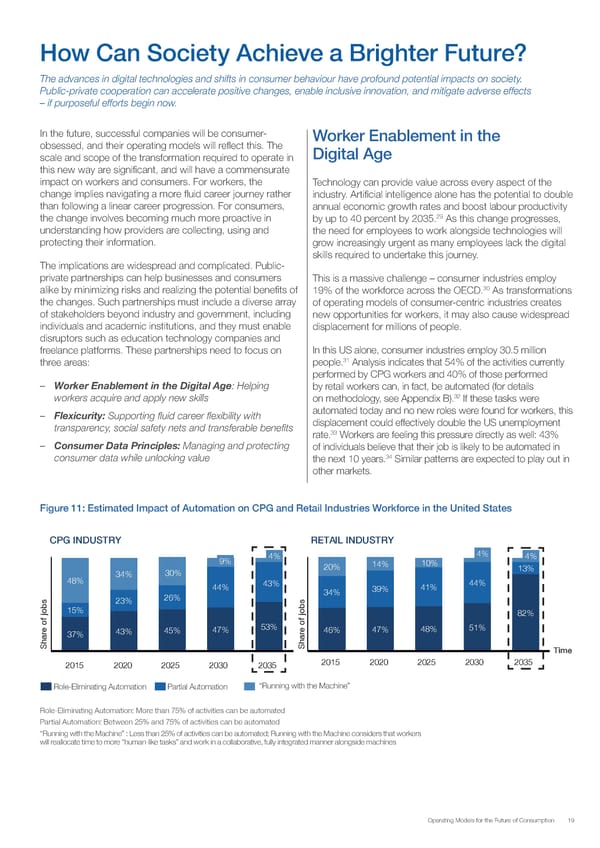How Can Society Achieve a Brighter Future? The advances in digital technologies and shifts in consumer behaviour have profound potential impacts on society. Public-private cooperation can accelerate positive changes, enable inclusive innovation, and mitigate adverse effects – if purposeful efforts begin now. In the future, successful companies will be consumer- Worker Enablement in the obsessed, and their operating models will reflect this. The Digital Age scale and scope of the transformation required to operate in this new way are significant, and will have a commensurate impact on workers and consumers. For workers, the Technology can provide value across every aspect of the change implies navigating a more fluid career journey rather industry. Artificial intelligence alone has the potential to double than following a linear career progression. For consumers, annual economic growth rates and boost labour productivity the change involves becoming much more proactive in 29 by up to 40 percent by 2035. As this change progresses, understanding how providers are collecting, using and the need for employees to work alongside technologies will protecting their information. grow increasingly urgent as many employees lack the digital skills required to undertake this journey. The implications are widespread and complicated. Public- private partnerships can help businesses and consumers This is a massive challenge – consumer industries employ alike by minimizing risks and realizing the potential benefits of 30 19% of the workforce across the OECD. As transformations the changes. Such partnerships must include a diverse array of operating models of consumer-centric industries creates of stakeholders beyond industry and government, including new opportunities for workers, it may also cause widespread individuals and academic institutions, and they must enable displacement for millions of people. disruptors such as education technology companies and freelance platforms. These partnerships need to focus on In this US alone, consumer industries employ 30.5 million three areas: people.31 Analysis indicates that 54% of the activities currently performed by CPG workers and 40% of those performed – Worker Enablement in the Digital Age: Helping by retail workers can, in fact, be automated (for details workers acquire and apply new skills 32 on methodology, see Appendix B). If these tasks were – Flexicurity: Supporting fluid career flexibility with automated today and no new roles were found for workers, this transparency, social safety nets and transferable benefits displacement could effectively double the US unemployment rate.33 Workers are feeling this pressure directly as well: 43% – Consumer Data Principles: Managing and protecting of individuals believe that their job is likely to be automated in consumer data while unlocking value 34 the next 10 years. Similar patterns are expected to play out in other markets. Figure 11: Estimated Impact of Automation on CPG and Retail Industries Workforce in the United States CPG INDUSTRY RETAIL INDUSTRY 9% 4% 4% 2% 2% 4% 4% 20% 14% 10% 34% 30% 28% 17% 13% 48% 44% 43% 39% 39% 41% 44% s 23% 26% s 34% 15% 81% 82% 53% 58% 69% 51% e of job37% 43% 45% 47% e of job46% 47% 48% Shar Shar Time Time 2015 2020 2025 2030 2035 2015 2020 2025 2030 2035 2040 2045 2050 Role-Eliminating Automation Partial Automation “Running with the Machine” Role-Eliminating Automation: More than 75% of activities can be automated Partial Automation: Between 25% and 75% of activities can be automated “Running with the Machine” : Less than 25% of activities can be automated; Running with the Machine considers that workers will reallocate time to more “human-like tasks” and work in a collaborative, fully integrated manner alongside machines Operating Models for the Future of Consumption 19
 Operating Models for the Future of Consumption Page 18 Page 20
Operating Models for the Future of Consumption Page 18 Page 20